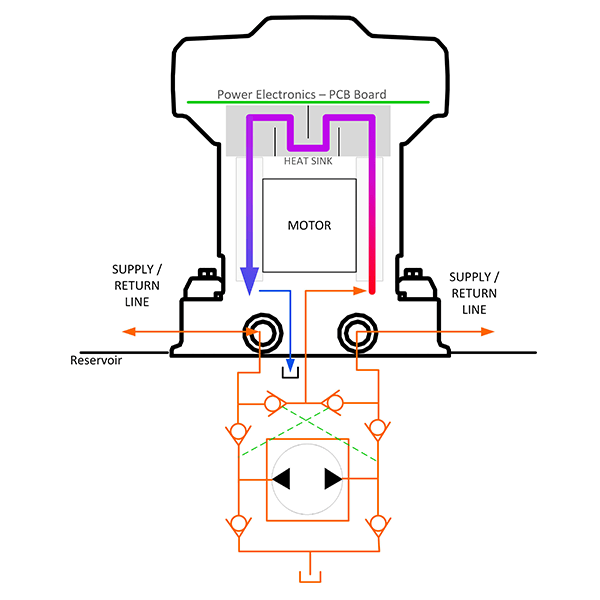Cooling
Hydrapulse® Technology
More Power With Less Heat In
Your Hydraulic System
Part of what makes Hydrapulse technology revolutionary is that it can provide hydraulic power with a new level of extreme efficiency in virtually any application. If you operate the Hydrapulse in a Direct Fluid Control method, you can reduce the heat generated by over 80% when compared with a traditional HPU with direction, pressure and flow control valves. If you operate the Hydrapulse in a Standard Pump Mode where it provides uni-directional flow to a valve bank like any traditional system, you can reduce heat by over 50% due to the power-on-demand functionality we provide. Either way, heat will be generated. What makes our technology completely unique is that the Hydrapulse is self-cooling, meaning that we actually utilize the hydraulic fluid to remove the heat from our power electronics (transistors) and our motor.
It’s a thermal game when it comes to designing products for the harsh fluid power industry and when heat is generated, you must do something with that heat to get it out of the system or off of the vehicle. This is typically performed with liquid to air heat exchangers (coolers for short). By blowing ambient air over the fins of a radiator that has oil flowing through it, you can transfer the heat from the oil into the air where it is dispersed into the environment. Oil coolers are standard equipment on most hydraulic power units, and we wanted to keep that knowledge and not introduce a new or overly complex method of cooling any heat generated from the Hydrapulse.
Low Pressure Return Technology
Our patent pending low pressure return cooling technology allows us to deliver a plug and play hydraulic power unit that does not require complex cooling via an external liquid cooling system, cooling fan, external fins, etc. We simply use the low pressure return oil from the hydraulic work function or valve bank to cool our motor and our electronics. It’s simple, yet groundbreaking technology.
One question we get a lot is: how do you cool the motor and electronics with potentially hot hydraulic oil? The answer is simple, temperature is relative. The hot hydraulic oil is at a maximum around 140°F to 160°F which is still much cooler than what the electronics operate at. So, a normally operating hydraulic system will still provide significant cooling to our power electronics and motor. This is one of the trade-offs for working in the harsh environment of fluid power.
Regardless of what mode or application you operate the Hydrapulse in, the motor and electronics are always automatically cooled with this integrated system.

